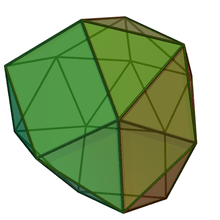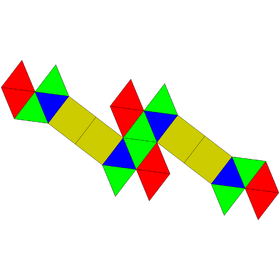Disphenocingulum
In geometry, the disphenocingulum or pentakis elongated gyrobifastigium is one of the Johnson solids (J90). It is one of the elementary Johnson solids that do not arise from "cut and paste" manipulations of the Platonic and Archimedean solids.
| Disphenocingulum | |
|---|---|
 | |
| Type | Johnson J89 - J90 - J91 |
| Faces | 4+2x8 triangles 4 squares |
| Edges | 38 |
| Vertices | 16 |
| Vertex configuration | 4(32.42) 4(35) 8(34.4) |
| Symmetry group | D2d |
| Dual polyhedron | Order-5 truncated snub disphenoid |
| Properties | convex |
| Net | |
 | |

3D model of a disphenocingulum
A Johnson solid is one of 92 strictly convex polyhedra that is composed of regular polygon faces but are not uniform polyhedra (that is, they are not Platonic solids, Archimedean solids, prisms, or antiprisms). They were named by Norman Johnson, who first listed these polyhedra in 1966.[1]
References
- Johnson, Norman W. (1966), "Convex polyhedra with regular faces", Canadian Journal of Mathematics, 18: 169–200, doi:10.4153/cjm-1966-021-8, MR 0185507, Zbl 0132.14603.
External links
This article is issued from Wikipedia. The text is licensed under Creative Commons - Attribution - Sharealike. Additional terms may apply for the media files.